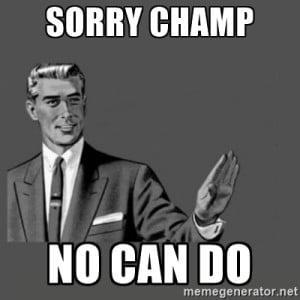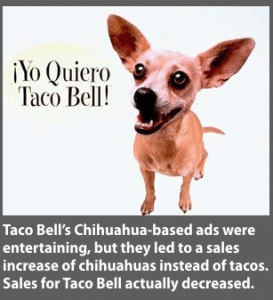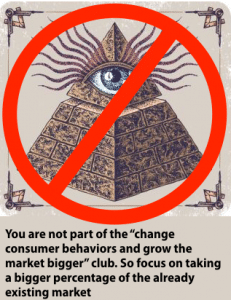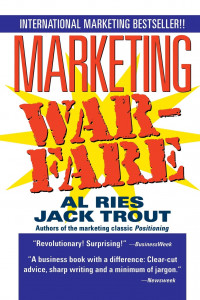 Genuine expertise always leaves clues.
Genuine expertise always leaves clues.
And in the ad business, the very best tell-tale sign is:
A professionally-honed understanding of what advertising CAN’T do.
In contrast, the Brand-babblers and unicorn-and-rainbows Social Media “experts” always believe their brand of magic pixie dust marketing can accomplish anything.
They have no sense of the hard realities involved in business competition and genuinely persuasive advertising.
Likewise, creativity worshippers tend to feel that while nothing works for sure, anything might work, so long as it’s rilly, rilly creative and the lightning strikes in their favor.
These fraudsters also have no appreciation for the limits that separate the can-do from the no-can-do.
Only marketing professionals paid on the performance of their ads are keenly aware of what doesn’t freaking work and what advertising simply can’t do.
And starting from the top, the most important No-Can-Do is this:
Advertising Can’t Make People Care About Anything They Don’t Already Care About.
This one covers a multitude of sins. So much so that both the Direct Marketing and the branding worlds have scorched it onto their psyches.
In the Direct-Marketing world, they embody this understanding in two important principles and maxims:
- What’s In It For Me (WIIFM)
All DM copywriters know they have to appeal to the prospect’s already existing, primal, and top-of-mind self-interests (or at least their self-identities). We’re talking stuff like the prospect’s looks, energy levels, wealth, libido, ability to forestall an early death, etc. If you can’t appeal to self-interest, you’re dead in the water because you can’t make people care about what they don’t already care about. - “The Money Is In The List”
Every Direct Marketer knows the most brilliant sales letter will fail if it’s sent to the wrong list. I don’t care how great your Hi-Fi stereo equipment sales letter is, it’ll still stink worse than a fart in church if it’s sent to a list of Amish farmers. If the people on your list don’t already care about the stuff you’re selling, you can’t make them care, let alone buy.
In the branding world, this principle is best explained with my marketing mentor’s maxim of:
“Speak to the dog, in the language of the dog, about what’s in the heart of the dog.”
When Pavlov did his whole trick with the bell and the salivating dog, he got it to work by starting with the taste of meat — by starting with something the dog already cared about.
If Pavlov had rung his bell every time he lit up a cigarette, there’d have been no drooling, no associative memory, and no Nobel prize — just an annoyed dog and a lot of annoying bell ringing.
You have to start with meat, which means you must associate your brand with a promise of things that are already “in the customers heart.”
The other way this influences branding is due to the nature of mass media.
With Mass Media, the vast majority of people hearing or seeing most any ad aren’t currently in the market for the advertised product or service.
Most people aren’t currently in the market for a new car, for HVAC repair, engagement rings, or carpet cleaning, or a lawyer, gym membership, etc.
Meaning that your ad won’t have intrinsic relevance for 90%+ of the audience. That sounds like a bad deal, but fortunately, it’s the so-called “wasted” part that works.
But the hard reality is that, in place of intrinsic relevance, your ad has to offer entertainment.
 People might not care about your otherwise “irrelevant” ad, they do care to be amused, intrigued, and entertained.
People might not care about your otherwise “irrelevant” ad, they do care to be amused, intrigued, and entertained.
Thus Howard Gossage’s immortal line: “People don’t read ads. They read what interests them and sometimes that’s an ad.”
So entertainment is crucial.
But there’s a catch: the entertainment has to be organic to the sales message, so your prospects can at least half-consciously absorb the desired branding and then involuntarily recall it when it’s time to buy.
You don’t want to spend your ad budget entertaining people without that paying off when audience members DO finally need what you sell.
Advertising Can’t Grow Your Market
Yes, in the simpler days of yester-year, a few companies with unimaginable ad budgets and access to societal levers of power were able to create or grow markets.
 Think of De Beers’ ability to move the tradition of a diamond engagement ring from 10% of the population to darn near 100%.
Think of De Beers’ ability to move the tradition of a diamond engagement ring from 10% of the population to darn near 100%.
But — and this is a BIG but — if you’re reading this, then you are NOT the “Illuminati.”
You don’t have that kind of ad budget, that kind of influence with the media, or that kind of access to the levers of power.
As a small or medium sized business, you’re never going to create growth in your category.
So if the total size of whatever market you’re in, in whatever locations you have is fixed, then the only way to increase your top line sales is to steal them from your competitors.
That’s a hard truth that any genuine advertising professional will be happy to tell you, and that no posing fraudster will ever willingly confront.
If you want your cash register to ring more often, you need to convince more people to spend their money with you instead of someone else. Which means your advertising HAS to take into account your competitive landscape if you’re going to successfully steal market share.
But it gets even stickier than that.
Branding as Theft and Warfare
 Because, as we established, your brand has to be attached to some value or promise the customer already cares about.
Because, as we established, your brand has to be attached to some value or promise the customer already cares about.
And within any category, there are only so many relevant brand values that the customer does care about.
So there’s a very strong chance your branding strategy will have to be based on theft and warfare.
Unless you’re the first to plant your flag on that hill, you’re going to have to take that hill by force or by guile.
When Duracell owned the brand promise of “long-lasting” in the minds of customers, Energizer had two choices: settle for “reliability” or fight Duracell for the long-lasting crown.
Enter the Energizer Bunny which kept fighting and fighting and fighting until it conquered mount Long Lasting.
And now that Energizer owns long lasting, Duracell has claimed the smaller territory of reliability. Why?
Because marketing can’t get people to care about things that people don’t already care about.
When it comes to batteries, people really only care about long lasting and reliable. That’s it.
And because Duracell can’t hope to grow the market for batteries bigger than it already is, they’re forced to work within the limits of what works in advertising — by what advertising can and can’t do.
Advertising can pound home a message about reliability. It can’t make people care about something they don’t already care about, or to buy batteries when they don’t need batteries.
How These Limits Should Affect Your Advertising
First, ask yourself the following questions:
- What values do customers already care about that tie in to what you sell?
- Do any brands already own those values in your industry, within your town? Or can you plant your flag on virgin territory?
- How do you plan on positioning yourself against any competitors who may “own” worthwhile values in the minds of customers?
- How do you plan on stealing market share? And which part of the market are you trying to seal?
If you can’t answer those questions on your own, then get a professional to help you with them.
And make sure you work with an ad pro who understands what advertising can do, and most especially, what it CAN’T do.
- Getting a Foot in the Door — Of Perception - November 27, 2025
- What Digital Superstars Know About Offline Advertising - November 17, 2025
- Unmistakable: A Tale of Two Boots and Branding Done Right - November 8, 2025
